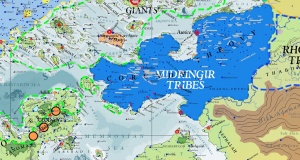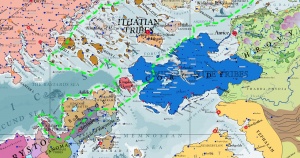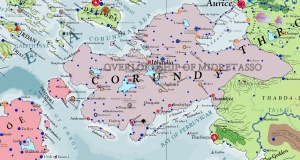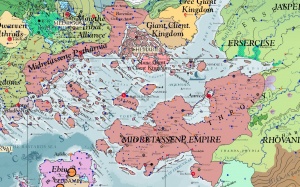Difference between revisions of "Midretassene Empire"
Trismegistus (talk | contribs) |
Trismegistus (talk | contribs) |
||
| Line 14: | Line 14: | ||
Midretassene necromantic practices did not originate from ancient [[Gwenyan]] customs, but were borrowed from [[Pytharnia]], either from the [[Moigthe]] or the [[Tuadbe]] and scholars generally believe that the ancient [[Neptultchi]] were the earliest source. Unlike the Yophentheans whose Arathracian religion was thoroughly intolerant of necromancy, Midretassene authorities often looked the other way or even enlisted the aid of necromancers in their wars of conquest. Midretassene necromancy achieved a high degree of professional excellence. | Midretassene necromantic practices did not originate from ancient [[Gwenyan]] customs, but were borrowed from [[Pytharnia]], either from the [[Moigthe]] or the [[Tuadbe]] and scholars generally believe that the ancient [[Neptultchi]] were the earliest source. Unlike the Yophentheans whose Arathracian religion was thoroughly intolerant of necromancy, Midretassene authorities often looked the other way or even enlisted the aid of necromancers in their wars of conquest. Midretassene necromancy achieved a high degree of professional excellence. | ||
| − | =Progression of | + | =Progression of Dominion= |
==Twelfth through First Centuries Before Salmakhamer== | ==Twelfth through First Centuries Before Salmakhamer== | ||
| − | Jathya-Dhumi Civilization, already weak from millennia of internecine conflicts and previous barbarian migrations from the east, collapses around the twelfth century before Salmakhamer, leaving a patchwork of princes, dukes, warlords, and independent city-states. Midringir Tribes under various chieftains, without any central ruler, migrate in waves from western [[Asdauria]] into the lands of Vindalia, formerly held by the once vast Kalaman Empire in millennia past. The vestiges of the [[Zhalayara Khuswa Dynasty]], the last of the [[Jatha-Nebir Kingdom]], gradually succumb to the nomadic tribesmen. | + | Jathya-Dhumi Civilization, already weak from millennia of internecine conflicts and previous barbarian migrations from the east, collapses around the twelfth century before Salmakhamer, leaving a patchwork of princes, dukes, warlords, and independent city-states. Midringir Tribes under various chieftains, without any central ruler, migrate in waves from western [[Asdauria]] into the lands of [[Vindalia]], formerly held by the once vast Kalaman Empire in millennia past. The vestiges of the [[Zhalayara Khuswa Dynasty]] (1163 AS to 1117 AS), the last of the [[Jatha-Nebir Kingdom]], gradually succumb to the nomadic tribesmen. |
==First Century== | ==First Century== | ||
| − | Around the time of Salmakhamer, the Midringir Tribes were a loose confederation that had conquered all of the core lands of ancient [[Kalama]] and what is now [[Throvy]]. [[Midringir Tribes]] employed horses and other beasts of burden and were still semi-nomadic in the first century. | + | Around the time of Salmakhamer, the Midringir Tribes were a loose confederation that had conquered all of the core lands of ancient [[Kalama]] and what is now [[Throvy]]. [[Midringir Tribes]] employed horses and other beasts of burden and were still semi-nomadic in the first century. Outside of [[Vindalia]], the Ithatian Islands, Maturn, Deliops, Zander, Desthor, and the Isles are ruled by various governments. In the Ambrinquan Peninsula, [[Ebinóë]] is under the rule of two neighboring kingdoms, Gorcorumb rules the [[Ephysgæee Mountains]], [[Kesheph]] is united under a single kingdom, and [[Narshad]] is united under its own sea-kingdom. |
[[File:Map_1stCentAI_MidringirTribes.jpg|thumb|300px|Extent of the Midringir Tribes]] | [[File:Map_1stCentAI_MidringirTribes.jpg|thumb|300px|Extent of the Midringir Tribes]] | ||
| Line 27: | Line 27: | ||
The transition from [[Midringir Tribes]] to Midretasso is under way. The tribes are largely settled, having adopted many of the customs of the Jathya-Dhumi and Kalaman civilization. | The transition from [[Midringir Tribes]] to Midretasso is under way. The tribes are largely settled, having adopted many of the customs of the Jathya-Dhumi and Kalaman civilization. | ||
| − | [[File: | + | [[File:Map_Midringir_100AI.jpg|thumb|300px|About 100 AI, Midretasso was spread through what is now [[Corundy]] and western [[Throvy]].]] |
==Third Century== | ==Third Century== | ||
Revision as of 13:13, 17 December 2018
The Midretasssene Empire developed from the Kingdom of Midretasso and remained essentially a monarchy through the imperial period, lasting through the first half of the first millennium after Salmakhamer until it was conquered by the Yophenthean Empire in the sixth century AI. Midretassene heritage remains strongest in the Tassan Plateau of eastern Corundy. Midretasso borrowed and retransmitted components of late Kalaman Civilization throughout its empire. Midretasso was known for its dark religious superstitions, strong military organization, necromancers, gladiatorial combats, and pretense of the rule of law.
Government
The classical structure of the Midretassene Empire was a hereditary ruler, the over-king with nearly absolute military power and limited civil powers. Civil power was held in the Curia under the direction of an elected Meddix whose function was similar to a prime minister or speaker. Outside of Corundy and Throvy, civil authority was limited and directly subject to the military governor appointed by the over-king.
Midretassene Religion
Midretassene Gods are cultural adaptations of the Isxinthion Gods, like most Gwenyan Cultures, with additional divinities from the steppes and ancient Kalama.
Necromancy
Midretassene necromantic practices did not originate from ancient Gwenyan customs, but were borrowed from Pytharnia, either from the Moigthe or the Tuadbe and scholars generally believe that the ancient Neptultchi were the earliest source. Unlike the Yophentheans whose Arathracian religion was thoroughly intolerant of necromancy, Midretassene authorities often looked the other way or even enlisted the aid of necromancers in their wars of conquest. Midretassene necromancy achieved a high degree of professional excellence.
Progression of Dominion
Twelfth through First Centuries Before Salmakhamer
Jathya-Dhumi Civilization, already weak from millennia of internecine conflicts and previous barbarian migrations from the east, collapses around the twelfth century before Salmakhamer, leaving a patchwork of princes, dukes, warlords, and independent city-states. Midringir Tribes under various chieftains, without any central ruler, migrate in waves from western Asdauria into the lands of Vindalia, formerly held by the once vast Kalaman Empire in millennia past. The vestiges of the Zhalayara Khuswa Dynasty (1163 AS to 1117 AS), the last of the Jatha-Nebir Kingdom, gradually succumb to the nomadic tribesmen.
First Century
Around the time of Salmakhamer, the Midringir Tribes were a loose confederation that had conquered all of the core lands of ancient Kalama and what is now Throvy. Midringir Tribes employed horses and other beasts of burden and were still semi-nomadic in the first century. Outside of Vindalia, the Ithatian Islands, Maturn, Deliops, Zander, Desthor, and the Isles are ruled by various governments. In the Ambrinquan Peninsula, Ebinóë is under the rule of two neighboring kingdoms, Gorcorumb rules the Ephysgæee Mountains, Kesheph is united under a single kingdom, and Narshad is united under its own sea-kingdom.
Second Century
The transition from Midringir Tribes to Midretasso is under way. The tribes are largely settled, having adopted many of the customs of the Jathya-Dhumi and Kalaman civilization.
Third Century
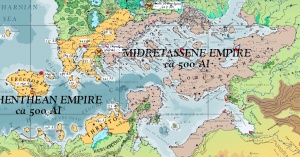
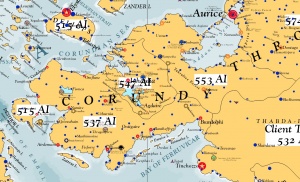
Chronology of Midretasso
- 800 AS
- 8th century AS Midringir tribes immigrate into the Kalaman Peninsula
- 700 AS
- 600 AS
- 500 AS
- 400 AS
- 300 AS
- 200 AS
- 2nd century AS Midringir Flampesha conflicts with Cetibrymio
- 100 AS
- 1st century AS, Cetibrymio becomes capital of united peninsula, becomes the core of the future Midretassene Empire
- 1 AI
- 53 AI, establishment of the Over-King of Midretasso
- 200 AI
- 287 Battle of Deliopian Strait, Midretasso conquers Deliops and the Ithatian isles
- 300 AI
- 327 Midretassene Conquest of Eastern Dúrandwor
- 397 Midretassene Conquest of Western Dúrandwor
- 400 AI
- 415 Battle of Curchása, Midretasso ensures its prolonged rule of Dúrandwor.
- 469 Battle of Danallo, Yophenthean defeat of Moigthe power in southwestern Pytharnia as part of the ongoing struggle between Yophenthea and Midretasso for control of Pytharnia.
- 492 AI to 513 AI Zelukian War Yophenthea wars against Midretasso and her allies
- 500 AI
- 513 Battle of Siul
- 515 Yophenthean Conquest of Deliops and Desthor
- 537 Yophenthean Conquest of western Corundy
- 547 Yophenthean Conquest of the Vimalian Plateau
- 552 Yophenthean Conquest of Dúrandwor
- 553 Yophenthean Conquest of Tassan Plateau (eastern Corundy) and southwestern Throvy
See Also
- List of the Over-Kings of Midretasso
- Midretassene Language
- Midretasso
- Midringir Tribes
- Necromancy in Ancient Midretasso
| This article is a stub. It requires further development by the creator. |
